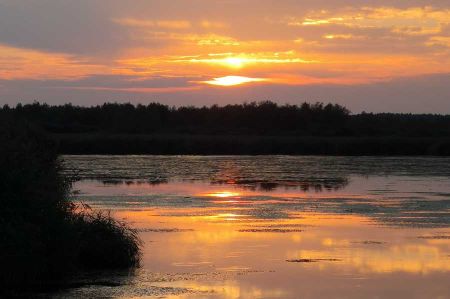Returning of starlings at Lake Federsee near Bad Buchau
- Written by Portal Editor
After “discovering” the Pile Dwelling Museum, our tour of Bad Buchau should lead to another highlight in the region that we had not expected.
During the tour, street names such as Seegasse indicated a lake, which we could not discover at first. Just at the Pile Dwelling Museum we did come across a first area of water and a wooden footbridge, which, accompanied by birches, was supposed to lead to the lake through seemingly endless reeds and other damp-proof plants. Despite the already advanced time, it was already 7 p.m., families with children kept arriving at the wooden jetty. We got information at the ticket booth, where a friendly NABU employee pointed out the upcoming arrival of the starlings, back from the fields to their sleeping places at Lake Federsee.
Federsee - paradise for water birds and not just for them
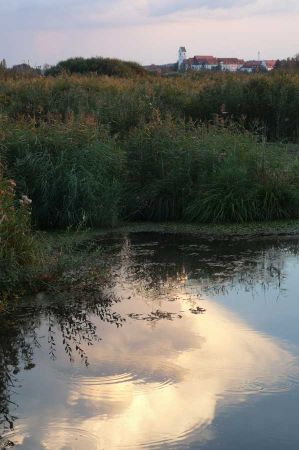 Lake Federsee near Bad Buchau in Upper Swabia is the second largest lake in Baden-Württemberg with an area of 1.4 km². It is located in the middle of the 33 km² largest contiguous moor area in southwest Germany and is with it the remainder of what was once a much larger post-glacial lake that covered around 50 km². This complex of lake and moor today represents the core of the geological Federsee basin, which after renaturation measures, with its former banks and islands, is now of outstanding natural and cultural historical importance.
Lake Federsee near Bad Buchau in Upper Swabia is the second largest lake in Baden-Württemberg with an area of 1.4 km². It is located in the middle of the 33 km² largest contiguous moor area in southwest Germany and is with it the remainder of what was once a much larger post-glacial lake that covered around 50 km². This complex of lake and moor today represents the core of the geological Federsee basin, which after renaturation measures, with its former banks and islands, is now of outstanding natural and cultural historical importance.
Today's basin landscape is now primarily a model for the ecological restoration of an already largely destroyed natural landscape, including its botanical and zoological habitats and the associated safeguarding and research of ancient cultural products that have existed since the middle of the 19th century after the lake level was lowered and drainage the moors came to light. Some of the remains of the pile dwellings are part of the UNESCO World Heritage Site.
Lake Federsee and the moor / reed that surrounds it in the central basin are now protected covering an area of 23.76 km², i.e. more than two thirds and was included by the European Union as part of the FFH area Federsee and Blinder See near Kanzach in its “Natura 2000” network of protected areas.
The Federseesteg is the only access to the Federsee
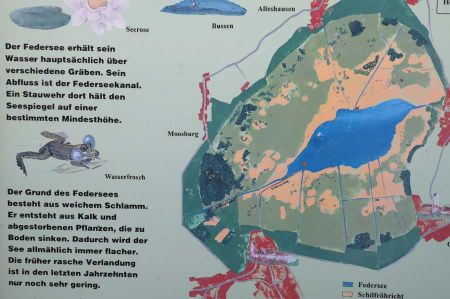 Lake Federsee moor offers nature enjoyment in every season. The landmark of Bad Buchau, the Federseesteg, is the best way to get to know the moorland habitats. It begins at the Federsee parking and leads visitors with dry feet over a distance of 1.5 km into the middle of the moor landscape.
Lake Federsee moor offers nature enjoyment in every season. The landmark of Bad Buchau, the Federseesteg, is the best way to get to know the moorland habitats. It begins at the Federsee parking and leads visitors with dry feet over a distance of 1.5 km into the middle of the moor landscape.
The Federseesteg crosses extensive, species-rich litter meadows, then the dense reed belt and ends at a visitor platform in the Federsee. There are excellent viewing opportunities for waterfowl. On the way, an observation tower enables spectacular views over the entire Federsee basin - on a clear day the chain of Alpine peaks shimmers in the south.
Comfortable benches along the footbridge invite you to enjoy and listen. Everywhere there is chirping, colourful butterflies flutter from flower to flower. Rare orchids show their noble splendour, grasshoppers chirp and colourful dragonflies stand in the air. The Federseemoor is the largest moor in southwest Germany with a fascinating biodiversity. Guided NABU tours show the rare bird life and the fascinating diversity of plants.
Some facts about footbridge construction in Bad Buchau
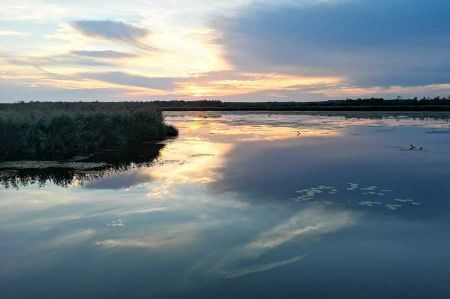 The footbridge was first built in 1911 and has been completely renewed four times since then. The last renewal took place in 2010 and 2011. The footbridge can just be built in winter when there is severe frost, as only then the otherwise soft moorland is accessible with construction machinery.
The footbridge was first built in 1911 and has been completely renewed four times since then. The last renewal took place in 2010 and 2011. The footbridge can just be built in winter when there is severe frost, as only then the otherwise soft moorland is accessible with construction machinery.
Length: 1,486 m
Built: First in 1911, renovated in 1949, 1961-65, 1983-85 and 2010/11
1,091 oak piles with a length of 7-14 m each (this results in a distance of 12 km)
475 m³ oak wood for railings, decking, refuge and observation tower
97.200 stainless steel screws
45,200 stainless steel nails
Entry of the starlings just in time for sunset
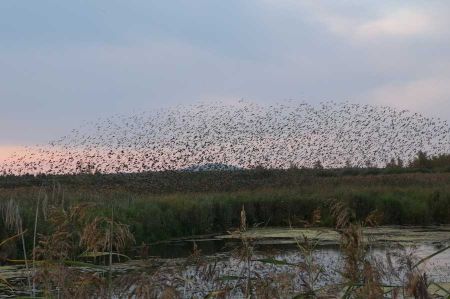 We had almost reached the end of the wooden footbridge when a first violent noise sets the air in motion, almost like a powerful gust: the first swarm of starlings reaches its sleeping zone. When the evening sun touches the horizon and thousands of starlings fall into the reeds, you can guess why mass birds have always impressed people, and sometimes even had to serve as horror scenarios (Die Vögel / Alfred Hitchcock).
We had almost reached the end of the wooden footbridge when a first violent noise sets the air in motion, almost like a powerful gust: the first swarm of starlings reaches its sleeping zone. When the evening sun touches the horizon and thousands of starlings fall into the reeds, you can guess why mass birds have always impressed people, and sometimes even had to serve as horror scenarios (Die Vögel / Alfred Hitchcock).
Mass sleeping places like here at the Federsee for the starlings are at least as spectacular as ornithological rarities. In addition to the starlings, crows, jackdaws, magpies and ravens already mentioned, thrushes, swallows, pipiters and wagtails also love to sleep socially, even if it takes a while for all individuals to agree on where to sleep. The same applies to cormorants, seagulls, hen harriers, black and red kites. The community grants protection from enemies, information about abundant food sources and one can get to know a breeding partner.
Often sleeping places are surprisingly close to people. Starlings even chirp in the ivy-covered walls in the pedestrian zone at night. In many European cities, star clouds with tens to hundreds of thousands of birds fall in the evening. On the main street of a southern German city, up to 250 wagtails sleep in a tree and crows are drawn to power lines and industrial areas. They show great tolerance to noise and other disturbances. Nevertheless, the advantages outweigh the disadvantages: The city is warm, has little snow and offers rubbish to eat, artificial light in short winter days, masts and tall trees as clearly arranged seats.
Even if it was only a brief moment when a new swarm flew in, it is a spectacle of nature that here at Lake Federsee in the middle of nature can be wonderfully observed.
Please read as well:
For interested birdwatcher - short stopover at Lake Volvi
Turkey - Bird watching at Lake Göksu
-
 Lake Federsee next to Bad Buchau
Lake Federsee next to Bad Buchau
Lake Federsee next to Bad Buchau
Lake Federsee next to Bad Buchau
-
 Lake Federsee next to Bad Buchau
Lake Federsee next to Bad Buchau
Lake Federsee next to Bad Buchau
Lake Federsee next to Bad Buchau
-
 Lake Federsee next to Bad Buchau
Lake Federsee next to Bad Buchau
Lake Federsee next to Bad Buchau
Lake Federsee next to Bad Buchau
-
 Lake Federsee next to Bad Buchau
Lake Federsee next to Bad Buchau
Lake Federsee next to Bad Buchau
Lake Federsee next to Bad Buchau
-
 Lake Federsee next to Bad Buchau
Lake Federsee next to Bad Buchau
Lake Federsee next to Bad Buchau
Lake Federsee next to Bad Buchau
-
 Lake Federsee next to Bad Buchau
Lake Federsee next to Bad Buchau
Lake Federsee next to Bad Buchau
Lake Federsee next to Bad Buchau
-
 Lake Federsee next to Bad Buchau
Lake Federsee next to Bad Buchau
Lake Federsee next to Bad Buchau
Lake Federsee next to Bad Buchau
-
 Lake Federsee next to Bad Buchau
Lake Federsee next to Bad Buchau
Lake Federsee next to Bad Buchau
Lake Federsee next to Bad Buchau
-
 Lake Federsee next to Bad Buchau
Lake Federsee next to Bad Buchau
Lake Federsee next to Bad Buchau
Lake Federsee next to Bad Buchau
-
 Lake Federsee next to Bad Buchau
Lake Federsee next to Bad Buchau
Lake Federsee next to Bad Buchau
Lake Federsee next to Bad Buchau
-
 Lake Federsee next to Bad Buchau
Lake Federsee next to Bad Buchau
Lake Federsee next to Bad Buchau
Lake Federsee next to Bad Buchau
-
 Lake Federsee next to Bad Buchau
Lake Federsee next to Bad Buchau
Lake Federsee next to Bad Buchau
Lake Federsee next to Bad Buchau
-
 Lake Federsee next to Bad Buchau
Lake Federsee next to Bad Buchau
Lake Federsee next to Bad Buchau
Lake Federsee next to Bad Buchau
-
 Lake Federsee next to Bad Buchau
Lake Federsee next to Bad Buchau
Lake Federsee next to Bad Buchau
Lake Federsee next to Bad Buchau
-
 Lake Federsee next to Bad Buchau
Lake Federsee next to Bad Buchau
Lake Federsee next to Bad Buchau
Lake Federsee next to Bad Buchau
https://www.alaturka.info/en/germany/baden-wuerttemberg/5163-returning-of-the-starlings-at-lake-federsee-near-bad-buchau#sigProId14e04c3b9a
